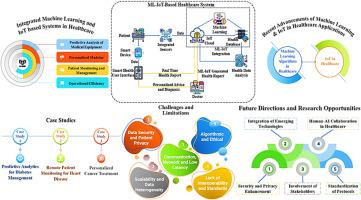Machine learning and IoT in healthcare: Recent advancements, challenges & future direction
引用次数: 0
Abstract
Background
The integration of Machine Learning and Deep Learning with IoT-enabled devices for real-time health monitoring has significantly revolutionized healthcare. These technologies facilitate the analysis of intricate medical datasets, yielding actionable insights that promote evidence-based clinical decision-making. Although significant advancements have been made, there is still an absence of a thorough synthesis regarding current applications, primary challenges, and prospective research directions. This review aims to synthesize recent applications, identify significant gaps, and propose clear direction for future research.
Methodology
A comprehensive narrative review was performed where a systematic literature search was conducted in PubMed and Scopus for studies published between 2020 and 2025. A total of 300 pertinent papers on ML and IoT's applications in healthcare were selected and analyzed to synthesize technological advancements, trade-offs, practical implications, challenges, and potential directions for future research.
Key findings
Neural network models, such as CNNs and ANNs, along with ensemble methods like Random Forest and XGBoost, often attain predictive accuracies ranging from 85 % to 95 %. Advanced technique, like generative imaging models, reinforcement learning, and transformer-based architectures, improve diagnostics, chronic disease management, robotic-assisted surgery, and predictive analytics, while explainable AI promotes clinical trust. Cloud-edge integration utilizing lightweight machine learning models enables real-time, energy-efficient applications, enhancing diagnosis, decision support, personalization, and cost-effectiveness, notwithstanding current challenges.
Conclusion
To conclude, the integration of ML and IoT is transforming healthcare through enhanced monitoring, improved predictive capabilities, and tailored treatment approaches. Addressing persistent limitations is crucial for fully realizing its potential and directing future research in this evolving field.

医疗保健中的机器学习和物联网:最新进展、挑战和未来方向
机器学习和深度学习与支持物联网的设备的集成,用于实时健康监测,极大地改变了医疗保健。这些技术有助于分析复杂的医疗数据集,产生可操作的见解,促进循证临床决策。尽管已经取得了重大进展,但仍然缺乏对当前应用,主要挑战和未来研究方向的全面综合。本文综述了该技术的最新应用,指出了存在的不足,并为今后的研究提出了明确的方向。方法在PubMed和Scopus中进行系统文献检索,对2020年至2025年间发表的研究进行全面的叙述性回顾。本文选取并分析了300篇关于机器学习和物联网在医疗保健领域应用的相关论文,以综合技术进步、权衡、实际影响、挑战和未来研究的潜在方向。神经网络模型,如cnn和ann,以及像随机森林和XGBoost这样的集成方法,通常可以达到85%到95%的预测精度。先进的技术,如生成成像模型、强化学习和基于变压器的架构,改善了诊断、慢性疾病管理、机器人辅助手术和预测分析,而可解释的人工智能促进了临床信任。尽管目前面临挑战,但利用轻量级机器学习模型的云边缘集成可以实现实时、节能的应用程序,增强诊断、决策支持、个性化和成本效益。总之,机器学习和物联网的整合通过增强监测、提高预测能力和定制治疗方法正在改变医疗保健。解决持续存在的局限性对于充分发挥其潜力和指导这一不断发展的领域的未来研究至关重要。
本文章由计算机程序翻译,如有差异,请以英文原文为准。
求助全文
约1分钟内获得全文
求助全文
来源期刊

Advances in biomarker sciences and technology
Biotechnology, Clinical Biochemistry, Molecular Medicine, Public Health and Health Policy
自引率
0.00%
发文量
0
审稿时长
20 weeks
 求助内容:
求助内容: 应助结果提醒方式:
应助结果提醒方式:


